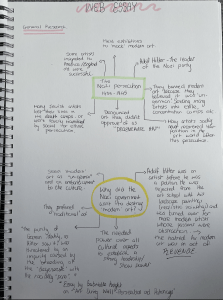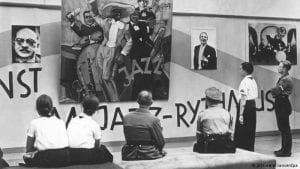Q.How the Nazi attack on modern art in Europe changed art in America.
I chose this title because the history and background really interested me. I found it fascinating that such horrid acts on the art and design community in Europe took place and for many of the artists this led them to having to flee in order to live peacefully and pursue their passions. I started by using my sketchbook and making spire diagrams about all of my starting knowledge on the subjects.
I then started out by looking at where it started and the history behind the Nazi government hatred towards the modern arts. This made me look into World War I and the first few most famous artists that had to escape Europe or were forced into exile.
I discovered that Adolf hitlers’ hatred for the modern arts was most likely catalysed from his own art rejection from school, before he became a politician, his work was unwanted and cast aside. The school was in favour of the more abstract pieces. Therefore the banishment of modern art was most likely an act of jealousy and revenge. The Nazi Government seen modern art as ‘un-German’ and believed it made a mockery of the German culture. However, they allowed some art to remain but Hilter had to have control over it all because he became aware that art had to power to control nations, and was able to portray powerful messages, influencing the public. Therefore, he had to take over the one most important city where art lived and thrived – Paris.
The Degenerate Art Exhibition
(images from ‘The Degenerate Art’ exhibition in Munich)
This was a major event that took place in Munich during Hitlers reign. The goal was to make a mockery of current artists work such as Joseph Geobbels, Paul Kee and Oscar Kokoschka in order to get it across to the public that these modern artists should not be representing the country of Germany. The art was displayed in unflattering ways with mocking commentary written all around the art itself, to encourage the millions of people that came to this exhibition how ‘un-German’ their work is.
I read more about this and was saddened by how many artists had to flee or were sent into exile, this is the list of names I found,
- Otto Dix
- John Heartfield
- Piet Mondrian
- George Groz
- Paul Kee
- Max Beckhann
and many more.
In my essay I plan to write about a few of these artists, the ones that immigrated to America and discuss there effect their art had there and furthermore the effect their art had on artists today.
In order to understand ‘degenerate art’ and why the Nazi government hated modernism so passionately, overall I wanted to find out as much information and history about it as I could so I read an essay by Gaberielle Knight titled ‘ Art During World War II, Persecution and Patronage’. This was written in 2020 which is great because the information and facts were recent and not outdated. Through reading I found out lots of facts that had been fact checked and supported by sources, I discovered interesting information. For example there was lots on the term ‘degenerate’ itself, and what it originally meant, I was more interested in what it meant to the Nazi party. I learned that ‘Modern’ art as “degenerate” was adopted and popularised during Hitler’s regime as a way to persecute artists associated with the modernist avant-garde.
I also read information on the irony of the Nazi party that I never knew before in this essay which was fascinating. The Nazi government held ‘degenerate art’ exhibitions and here they sold the art they believed to be so ‘degenerate’ rather than destroy it, furthermore people who bought these modern art pieces contributed to fund the Nazi party. These hypocrisies are revealed through the pattern in both works in which Nazi personal and financial advancement outweigh a consistent application of persecution through the ideology of the “degenerate”.
Gabrielle Knights essay:
I found that reading this essay gave me a closer insight to what persecution the Nazi Government put artists through, furthermore giving me a clearer understanding as to what to include in my essay. I then decided to chose important and relevant artists that I believed had a real effect on the modern art in America that hadn’t existed there before, or wasn’t have as popular until these artist arrived.
I knew I wanted to include Piet Mondrian because of his revolutionary work in De Stijl and how he expanded into all areas of the arts for example, architecture, interior design, graphics and so much more. Through further research I discovered his success in America and how his work is still being admired and appreciated today. I found that there was a festival held in his honour marking a ‘Century of Mondrian’, to admire how his work has been used for over 100 years in various art fields. I also wanted to focus on Modrian because I had already researched a lot about him for our Group project and this made me want to learn even more.
I then researched his work and found that people design their houses and buildings inspired by his work.
(A landmark home in San Francisco)
(City Hall in The Hague in The Netherlands)
Other artists
I plan to write about a few other artists during my essay that also had a huge effect on art in America after they were exiled during the Nazi persecution. I want to focus on abstract artists that helped to encourage modern art in America. I found two names that stuck out to me.
Josef Albers and László Moholy-Nagy are two abstract artists that I wanted to possibly include in my essay because they have similar traits in common with Mondrian. They all had to leave their careers in Europe and restart their lives in America, further changing the face of modern art in American society.

(Yellow Circle 1921 László Maholy-Nagy)
These are the first images that caught my eye when studying their work. I thought both paintings reflected qualities in Piet Mondrian’s work during De Stijl. The colours are similar, the primary yellow, reds and blues, and also the shapes reflect one another for example the lines and squares – just like Mondrians’ work for example:
I think these artists and images will all tie my website nicely together and the primary colours colour palette will look simple yet effective.










